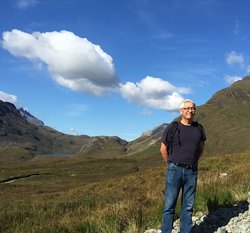John S. Allen is the author of the new book Home: How Habitat Made Us Human. His other books include The Omnivorous Mind and The Lives of the Brain. He is a research scientist at the University of Southern California and a research associate at Indiana University. He lives near Lexington, Kentucky.
Q: You ask, "How did feeling at home come to be so
important?" How did the concept of "feeling at home" change over
time, and how did it develop the importance it has today?
A: About two million years ago, we see some of our ancestors
beginning to show an increase in brain size beyond what you might find in the
great apes. You have to keep in mind, they have already distinguished
themselves from other apes by walking around on two legs, probably starting four
million years before that, at least.
But a bigger brain (and it ultimately triples in size from
an ape version) needs both more energy to maintain and time during childhood to
train. Raising and maintaining these larger brains probably led to more intense
family and social relationships; in addition, there was an increase in
technological sophistication, including tool use and using fire.
These relationships and technologies were probably enhanced
by the development of what some archaeologists have called a "home
base," the precursor to home. So the importance of home goes back a long
time.
As for the "feeling at home," we associate a range
of feelings and emotions with home: security, comfort, an expectation of rest
and recovery, empathy for those with whom we share a home, and so on.
None of these feelings are unique to home. But a feeling for
home emerges from the combination of these basic cognitive processes, the
association of place with significant relationships, and our cultural
propensity to define and build places to live within larger social groups.
As we grow up, an ability to feel at home becomes adaptive,
just as learning a specific language or the "right" foods to eat is
adaptive for a child when she grows up.
Q: In the book, you discuss homesickness, and how it's often
seen as a sign of weakness. Why is that, and how do you feel it should be seen?
A: Homesickness has been described as a
"mini-grief," which in itself is an indication of how the loss of
home is the loss of a significant relationship.
As a nation of immigrants, America was a country built on
the idea that one leaves home behind to better one's circumstances. Today,
mobility in a geographic sense is often tied to upward mobility in a
socio-economic sense.
Homesickness can therefore be seen as getting in the way of
achieving at least one version of the American dream. For some people, that is
definitely a sign of weakness.
Q: You talk about the distinction between "house"
and "home." How would you define the two, and what are the areas of
overlap?
A: Although it was somewhat arbitrary, in the book, I
differentiate between the motley array of structures, grand and modest, that
humans build to live in (houses) and the place we live with which we have an
emotional connection (home).
Home is made from the inside of our minds out. We can feel
at home in a vast array of structures and even in wide-open spaces on the
landscape.
As a species, the feelings underlying home are far more
universal than the structures we live in. In that sense, we are quite different
from say, organ pipe wasps and prairie dogs, other animals that live sheltered
lives.
Q: What do you see looking ahead when it comes to concepts
of "home"?
A: In American society today, the tiny and tidy house movements
hint at a growing awareness that where we live is more important than the
square footage we occupy and the stuff we fill that space with.
These things can be seen as a distraction from achieving a
more salubrious home feeling, which should be based on the ability of home to
provide a restful environment to recover from the outside world and an arena
for social interaction with those with whom we share significant relationships.
Explicitly recognizing the cognitive value of home, in
addition to the economic value of a house or the educational value of a
neighborhood with good schools, etc., should expand our concepts of home in a
productive direction.
Q: What are you working on now?
A: I am working on a topic related to the history of
anthropology and race. As an anthropologist of Asian and European ancestry,
this is an area that is of great personal significance for me.
Q: Anything else we should know?
A: Nope--thanks for the interview!
--Interview with Deborah Kalb




No comments:
Post a Comment